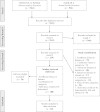Component costs of foodborne illness: a scoping review
- PMID: 24885154
- PMCID: PMC4041898
- DOI: 10.1186/1471-2458-14-509
Component costs of foodborne illness: a scoping review
Abstract
Background: Governments require high-quality scientific evidence to prioritize resource allocation and the cost-of-illness (COI) methodology is one technique used to estimate the economic burden of a disease. However, variable cost inventories make it difficult to interpret and compare costs across multiple studies.
Methods: A scoping review was conducted to identify the component costs and the respective data sources used for estimating the cost of foodborne illnesses in a population. This review was accomplished by: (1) identifying the research question and relevant literature, (2) selecting the literature, (3) charting, collating, and summarizing the results. All pertinent data were extracted at the level of detail reported in a study, and the component cost and source data were subsequently grouped into themes.
Results: Eighty-four studies were identified that described the cost of foodborne illness in humans. Most studies (80%) were published in the last two decades (1992-2012) in North America and Europe. The 10 most frequently estimated costs were due to illnesses caused by bacterial foodborne pathogens, with non-typhoidal Salmonella spp. being the most commonly studied. Forty studies described both individual (direct and indirect) and societal level costs. The direct individual level component costs most often included were hospital services, physician personnel, and drug costs. The most commonly reported indirect individual level component cost was productivity losses due to sick leave from work. Prior estimates published in the literature were the most commonly used source of component cost data. Data sources were not provided or specifically linked to component costs in several studies.
Conclusions: The results illustrated a highly variable depth and breadth of individual and societal level component costs, and a wide range of data sources being used. This scoping review can be used as evidence that there is a lack of standardization in cost inventories in the cost of foodborne illness literature, and to promote greater transparency and detail of data source reporting. By conforming to a more standardized cost inventory, and by reporting data sources in more detail, there will be an increase in cost of foodborne illness research that can be interpreted and compared in a meaningful way.
Figures

References
-
- World Health Organization. Initiative to Estimate the Global Burden of Foodborne Diseases. First formal meeting of the Foodborne Disease Burden Epidemiology Reference Group. Geneva, Switzerland; 2013. Retrieved from: http://www.who.int/foodsafety/publications/foodborne_disease/burden_nov0....
-
- Kuchenmuller T, Hird S, Stein C, Kramarz P, Nanda A, Havelaar AH. Estimating the Global Burden of Foodborne Diseases – a Collaborative Effort. Eurosurveillance. 2009;14(18):1–4. - PubMed
-
- World Health Organization. The Global Burden of Disease. Geneva, Switzerland; 2004. Retrieved from: http://www.who.int/healthinfo/global_burden_disease/GBD_report_2004updat.... Accessed June 2013.
Publication types
MeSH terms
Grants and funding
LinkOut - more resources
Full Text Sources
Other Literature Sources
Medical
Miscellaneous

